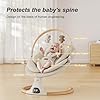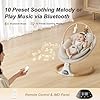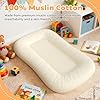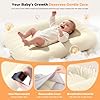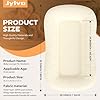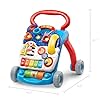Baby Swings for Infants, Monamii Baby Swing, Infant Swing with 5 Speeds, 10 Lullabies, Electric Swing for Baby, Indoor & Outdoor Use (Beige)
20% OffJylvo Baby Lounger, Portable Baby Lounger for Newborns to 24 Months, Soft & Breathable Infant Nest with Thickened Support, Newborn Baby Essentials Gift for Home and Travel,Gray
23% OffNewborns have varying nutritional needs depending on their age. For instance, toddlers like to eat more often compared to tiny newborns. Generally for newborns to grow well, they need to feed 8-12 times a day (24 hours). However, before starting to feed your baby, you need to establish a useful newborn feeding chart or plan.
In this article, we are going to discuss how to adequately feed your newborn based on the baby’s feeding behaviors. However, the suggested amounts of meals that the baby should consume are a recommendation. Therefore, you have nothing to worry about when your newborn eats less than the recommended amount.

Huggies Little Snugglers Baby Diapers
Introducing Huggies Little Snugglers Baby Diapers, the perfect choice for providing your baby with comfortable and reliable protection. Designed with your baby’s needs in mind, these diapers offer exceptional comfort, superior absorption, and gentle care for your little one’s delicate skin. Invest in Huggies Little Snugglers and experience worry-free diapering for your baby.
12-Month Newborn Feeding Chart for Your Baby
The feeding pattern for every baby changes with time. The types of food that every child feeds on vary with each feeding stage. As a parenting mother, you should use the following feeding guidelines to keep your baby healthy.
Read About understanding the basics of a two-month-old baby
Between Birth to 3 Months (Newborn Feeding)
During this period, the baby only relies on the nutrients from breast milk or sometimes formula. The newborns should feed on breast milk after every 3 hours upon demand. The newborn’s tummies are usually small. Therefore, you don’t have to force your newborn to take more milk when the stomach is already full.
With the formula, consider feeding your child after every three to four hours. That is six to eight feedings in 24 hours. Because the newborn’s tummy is still developing, do not feed your baby solid foods such as grains, fruits, vegetables, and meat.
Every feeding should range from 1 to 3 ounces. However, at two months old, the baby can take up to 5 ounces in every feeding (after 3-4 hours).
Between 4 to 6 Months (Infant Feeding)
At this age, the baby can start eating semi-solid foods. At four months of age, the baby can take between 5 to 6 ounces per feeding. However, this may increase with time. After every four days, you can give the baby new foods while taking note of any allergic reactions that may result.
During this period, do not feed your baby a lot of fruit juices, salted foods, and sugared foods. The regular feedings per day of breast milk should range from six to eight feedings. Grains such as cereals (iron-fortified) mixed with formula or breast milk can be perfect for the newborns’ growth.
Other foods that you can feed your newborn include pureed vegetables, fruits, meat, and unsweetened yogurt. Note that the meals should be smooth without solid lumps.
| Age of Baby | Average Amount of Breast Milk or Formula per Feeding | Expected Number of Feedings per Day |
| Newborn | 1 to 2 ounces | 8 to 12 feedings |
| 2 weeks | 2 to 3 ounces | 8 to 12 feedings |
| 1 month | 3 to 4 ounces | 8 to 10 feedings |
| 2 months | 4 to 5 ounces | 6 to 8 feedings |
| 4 months | 4 to 6 ounces | 6 to 8 feedings |
| 6 to 12 months | 7 to 8 ounces | 4 to 6 feedings |
Between 6-9 Months (Infant Feeding)
During this period, the baby’s breast milk intake reduces to about four to six feedings in 24 hours. Most infants feed themselves at about eight months of age. It is at this age that you should try giving your baby some soft solid foods such as bananas, mashed potatoes, minced meat, and cooked vegetables.
Because your baby may be ready to eat solid foods at that age, you can begin giving your baby finger foods such as rusks. Other meals include pureed legumes, cereals that are iron-fortified, and pureed tofu. Consider introducing new foods every three to five days.
Between 9-12 Months (Toddler Feeding)
At this age, the baby should be able to eat various foods including solid foods. It is at this stage that infants would pick anything and put it into their mouth. For that reason, babies find it easy to pick and chew solid foods slowly without the help of their parents. However, breast milk of up to 4 feedings in a day may still be vital for growth.
The baby may eat any solid food you give. But if the baby has difficulty feeding a particular type of food, you ought to try it again the following day. The infant should eat foods such as fortified grains or cereals of about three tablespoons, fruits and vegetables, yogurt, and meat.
At the age of one year, your child should be able to eat what the rest of your family is eating without any difficulty. However, you should offer nutritious meals to your growing kid. Babies at this age may eat little amounts of food but frequently. Therefore, you ought to develop a workable newborn feeding chart.
A good newborn feeding chart should record the number of times your baby should eat in a day, the types of foods, and the specific amounts of foods.
Feeding Tips for Newborns
- Monitor your Newborn’s Feeding Pattern
Your newborn’s feeding pattern may vary with days. The baby may not necessarily consume the same food amounts every day. However, you should always be on the lookout to note signs of hunger. A newborn feeding chart can help you to monitor your baby’s feeding behavior and pattern.
- Consider Nutrient Supplements
In some cases, you may need to take nutrient supplements such as Vitamin D as recommended by the pediatrician. Such supplements are essential during breastfeeding. For instance, Vitamin D stimulates the development of strong bones in your baby.
- Introducing New Foods
Feeding is a continuous learning process in a newborn. While feeding your baby, you need to introduce every new food as your child grows, especially between 9 to 12 months of age.
- Know Your Baby’s Hunger Cues
As a parent, you should understand how your child acts when hungry. In most cases, babies cry when hungry. However, this may not be true with some newborns. Some may lick their lips when hungry.
What to Consider in a Newborn Feeding Chart
Feeding Frequency: Frequent feeding may reduce the time it takes for more milk to manufacture. In the limited supply of milk, you may use a formula to supplement the standard milk requirement.
Importance of Frequent Feeding
Frequent feeding is essential for a growing newborn. Here are some of the benefits of frequent newborn feeding.
- Helps the newborn to gain enough calories from the milk
- Promotes the development of the newborn’s body such as increased body weight
- Increase the prolactin level in the mother which stimulates the production of more milk
Final Word
In conclusion, developing a feeding chart for newborns is essential to ensure that they grow up healthy. The feeding pattern of every baby changes with age, and the types of food that they consume vary with each feeding stage. For newborns between birth and three months, breast milk or formula is the only source of nutrients, and they should feed every three hours upon demand. At four to six months, infants can start eating semi-solid foods, but parents should avoid giving them salted, sugared, or fruit juices. Between six and nine months, breast milk intake reduces to four to six feedings per day, and parents can introduce soft solid foods. At nine to twelve months, infants can eat any solid food given to them, but nutritious meals are essential for their growth. Finally, parents should offer little amounts of food frequently and record their baby’s feeding on the chart.
FAQs
What is the normal amount to feed a newborn?
If your baby is only being fed with infant formula and not breast milk, you can begin by offering them 1 to 2 ounces of formula every 2 to 3 hours during the initial days after birth. If your baby appears to be hungry, you can increase the amount of formula. Typically, newborns fed with infant formula will need to feed 8 to 12 times within a 24-hour period.
Feeding a baby excessively can cause discomfort as they may not be able to digest all of the breast milk or formula properly. It can also cause them to swallow air which may result in gas, belly discomfort, and crying.
Related Links:
- https://en.wikipedia.org/wiki/Newborn_care_and_safety /By Wikipedia
- https://en.wikipedia.org/wiki/Baby_food /By Wikipedia
- https://www.wikihow.com/Category:Baby-Feeding-and-Nutrition /By Wikihow
- https://www.wikihow.mom/Feed-a-Baby-or-Infant-Solid-Food /By Wikihow
- https://www.wikihow.life/Feed-Twins /By Wikihow
- https://www.wikihow.com/Plan-a-Healthy-Diet /By Wikihow
- https://www.wikihow.com/Maintain-a-Balanced-Diet /By Wikihow

Hi there!
My name is Sabrina. As a devoted mother of four children, I have personally experienced the benefits and effectiveness of various types of baby swings. As the founder of babyswingclub.com, I have dedicated myself to providing valuable information and insights into the world of baby swings.
My thorough research and hands-on experience allow me to offer valuable insights into the features, safety standards, and overall performance of different baby swings.




